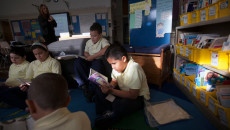LatinaLista — What do the District of Colombia, Oregon, Arizona, New Mexico and Florida have in common? If you guessed these are the new battleground territories, you would be half right. Each of these states and the District of Colombia share a sad distinction — they are the top 5 places in the nation where children battle to get enough to eat and end up going to bed hungry.

In fact, according to a new report released by Feeding America titled Map the Meal Gap: Child Food Insecurity 2012 , every county in the United States has children who are going hungry.
Some counties are worse than others.
Zavala, Texas has the highest rate of food insecurity in the nation with nearly half of the children there at risk of hunger.
There are more than 640,000 food insecure children in Los Angeles County.
The study found that over sixty percent of the children who have high food insecurity live in the rural areas of the nation. Ironic given that the farm fields are literally in their backyards.
Trying to explain why food insecurity exists is as simple as looking at the state of the economy. The report’s authors found that it’s no longer sufficient to just say that poor people are hungry. They discovered from national food insecurity data that 58 percent of people struggling with hunger have incomes above the federal poverty level and 59 percent of poor households are actually food secure.
One of the reasons is that those with an income above the federal poverty level are making choices — mortgage or food; utilities or food; gas or food? A roof over the heads, water to bathe and drink, electricity and filling up the family car to get to work win out for most people.
With the report, the author’s provided an interactive map based on 2009 and 2010 data that instantly shows the prevalence of children going hungry in every county and congressional district in the country.
“In order to meet the needs of children who are food insecure, we need to look at the communities in which they live,” said Vicki Escarra, president and CEO of Feeding America, the nation’s largest hunger-relief organization. “For example, if we find that there are significant numbers of children in a particular county who are entitled to be enrolled in child nutrition programs, but are not, our priority should be to increase enrollment.
“On the other hand, we also need to know if there are a number of families whose household income is too high, or who have too many financial assets, to qualify for these programs. If the only way to get additional food to them is through charities, such as the agencies served by our food banks, then we know we need to make that our priority.”
With a long, hot summer ahead and no chance for free lunches or breakfasts for too many children now that school is out, the chances of more children feeling those hunger pangs is bound to get worse. This is one group of children for whom school doesn’t just feed their minds but fills up their tummies.




